Good Molecules is a brand with a pretty unique marketing strategy – they show their ingredient lists with the percentages of all the ingredients, saying they have “nothing to hide”.
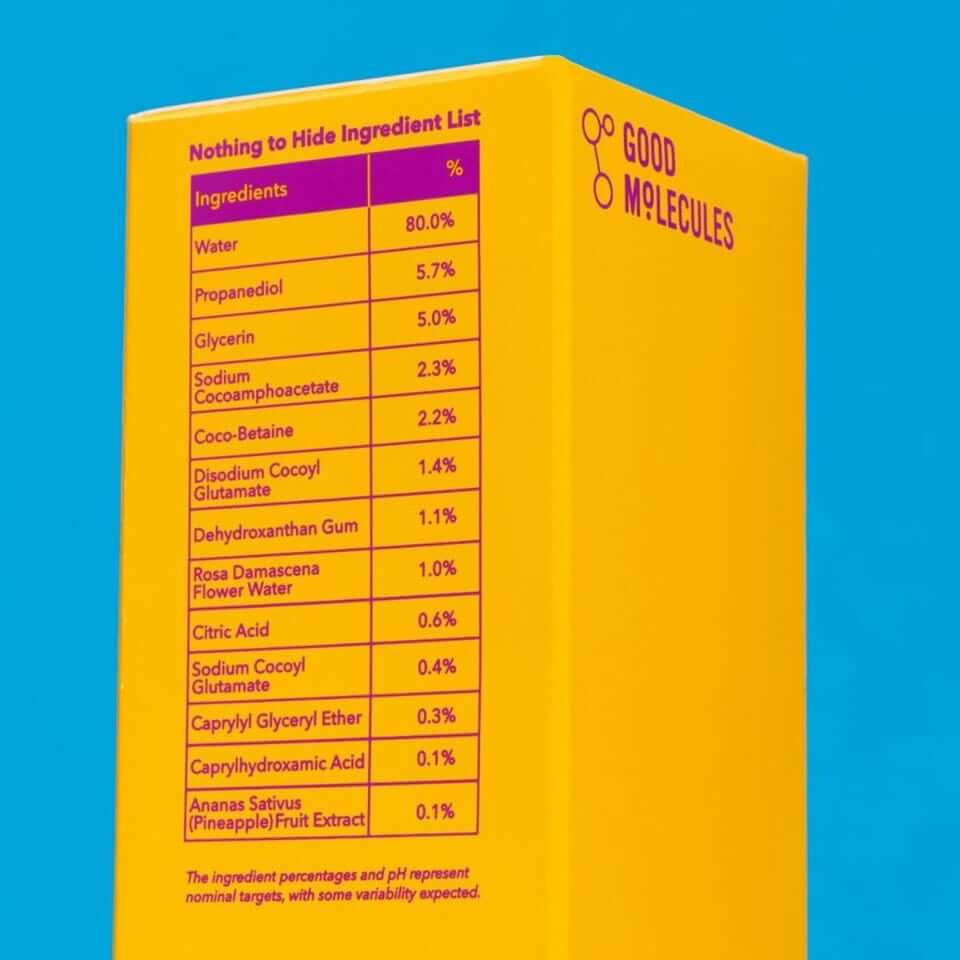
They claim this is a “new level of transparency”, and that they hope that others in the industry will do the same… but is that really transparent?
The YouTube video is here, keep scrolling for the text version.
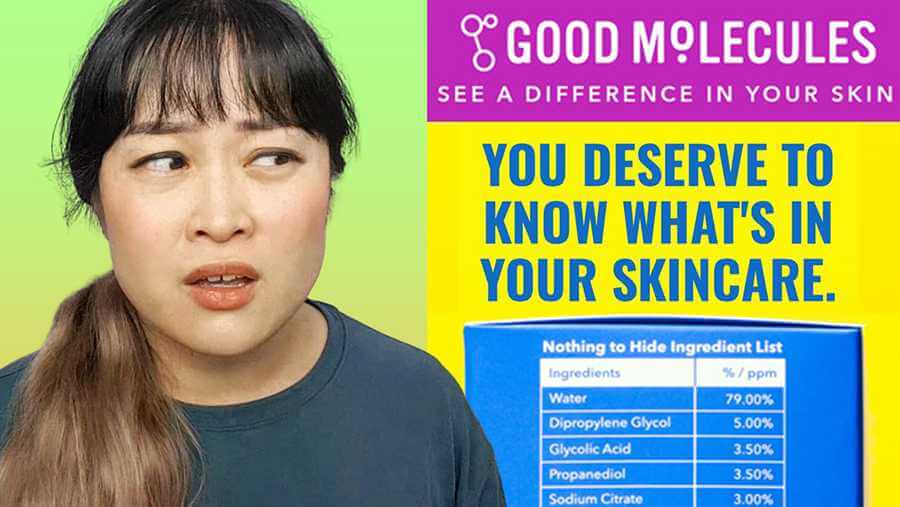
On the face of it, this approach definitely looks sciencey. You have lots of numbers, they go from biggest to smallest. Some of these ingredients go to two decimal places, which gives you at least four units of scienceness.
Related post: Scientism or “Science-Washing” in Beauty
But I think there are some really big issues with this marketing that might not be immediately obvious.
Ingredient lists don’t tell you much
First off, you can’t tell everything from an ingredient list. A standard ingredient list gives you all of the ingredients in descending order by percentage mass, from the heaviest to the lightest. Once you go below 1%, the ingredients can be in any order.
One of the big issues with this is that you don’t know the exact percentage of each ingredient, and you can only really guess at the 1% line. But even if Good Molecules gives you the exact percentages, there are other issues too…
Ingredient variation and quality
A lot of ingredients have a range of different qualities, even if they have the same name on an ingredient list (often called the “INCI name”).
Natural ingredients like oils and plant extracts will be affected by lots of different factors, like where you get them from (the country of origin, the exact farm), the time of year. Plant extracts can also be extracted with different solvents, which changes the composition of the extract in terms of which chemicals are actually in it, and in what proportions.
A lot of ingredients have different levels of important impurities. For example, niacinamide often contains niacin (nicotinic acid) as an impurity, which can cause skin to flush. Flushing from niacinamide is often due to the presence of niacin (whether it’s present as an impurity or the niacinamide has converted to niacin over time), so more careful brands might look for a source of niacinamide that has less of the niacin.
Blended materials
There are also blended materials, which contain multiple substances under the one ingredient name. For example, cetearyl alcohol is a mix of cetyl and stearyl alcohols, and you don’t know how much there is of each one from the ingredient name alone.
Blended materials can also make the list itself inaccurate, even if everyone’s done their due diligence to make it as accurate as possible. The cosmetic chemist has to calculate the mass percentages for the ingredient list, but sometimes an ingredient supplier will give you percentage ranges for components rather than a precise percentage.
For example, Hallstar NCD-20’s data sheet says it has 50 to 80% cetearyl alcohol and 20 to 50% ceteareth-20, and the exact percentages are a trade secret. The usual practice is to take the midpoint (i.e. 65% cetearyl alcohol and 35% ceteareth-20) and calculate the mass percentages for the INCI list order from that, even though it’s almost certainly not the actual percentage. So the INCI list isn’t as precise as you might believe.
Unstable ingredients
There’s also the issue of stability. Even if you put in a particular ingredient at a particular percentage at the start, that might not be what you get in the product by the end. Ingredients like retinol are pretty unstable, so by the time it arrives on your doorstep the original 1% retinol might be, say, a fifth of that.
Related post: Choosing retinol products: Neutrogena Rapid Wrinkle Repair Regenerating Cream
General names
Some INCI names are also used for multiple ingredients. For example, dimethicone is a polymer that comes in lots of different lengths. The length changes the properties of the ingredient, so short polymers of dimethicone are runny and light, while long polymers are a lot thicker and stickier. The name “dimethicone” is used for both of these, and everything in between.
Related post: Busting Hair Conditioner Myths: Build-Up, Silicones, Weighing Hair Down etc.
This also happens for “carbomer”, which is the general name for a whole bunch of different polymers used for thickening.
How are the ingredients arranged?
It’s also really difficult to tell if there’s some sort of special delivery system in the product. For example, encapsulating ingredients can change how well they work – a lower percentage of encapsulated retinol can work just as well as a higher percentage of regular retinol.
This ingredient list, even with the percentages, doesn’t have any transparency with these aspects because they’re only using the standard INCI ingredient names.
Do we get more useful information?
The other issue with this strategy is you end up with a whole bunch of really useless info that no one really needs. I think this actually makes it less transparent, because now it’s a lot more confusing. There’s a whole bunch of distractions, and you can’t just zero into the stuff you actually want to know.
You do get the percentages of every active ingredient, which I think is useful. Even though there are differences in potency and quality and that sort of thing, I still like to know roughly what I’m expecting.
But now we also have all the percentages of the inactive ingredients which… who cares?
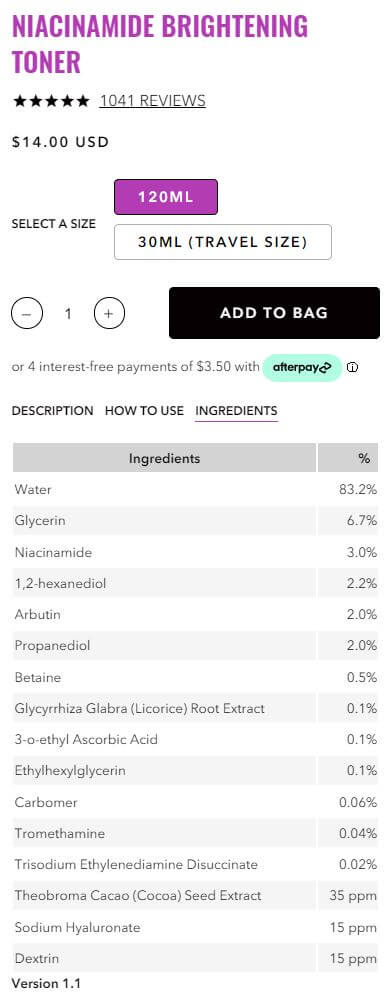
The ingredient list for the Niacinamide Brightening Toner tells me there’s 83% water. But that doesn’t make me more or less likely to buy the product compared to a different product that had 87% or 75% water. Propanediol is at 2% – I would still buy it if it was at any percent, really, as long as I trusted the brand.
Carbomer is at 0.06%. This is a rheology modifier that changes the texture of the product. But you could work out the product of the texture better by just putting it on your hand, or reading a review. A review that said if it was tacky/drying/sticky/thick, or a video of someone applying it on their face or the back of their hand would be far more useful!
These percentages aren’t even useful that for cosmetic chemists who wanted to copy the formula (this process is called reverse engineering). It would give me an easier starting point, but there’s still a ton of trial and error involved because there are so many different ingredients that can be listed under the one INCI name.
For example, there are hundreds of different ingredients that “carbomer” could represent, and those will produce different textures in the final product. I’d still have to decide on the carbomer based on my best guess, make the product, then check the texture and then adjust it until it matched.
I do like having the active ingredient percentages. But lots of brands already tell us this, so it’s not exactly giving us “radical transparency”.
I guess I’d appreciate it if more brands listed active ingredient percentages – maybe with some disclaimers about potency. For example, if they’re using a particularly potent version of an ingredient, it’d be nice to know the equivalent percentage for a more standard product. A lot of brands don’t like to say the percentages because it’s a bit more difficult to explain, and many people do end up reducing the product to percentages. But I think it’d be nice if that information was perhaps hidden away somewhere on their website, so the nerdier people could still find it.
What do these ingredient lists tell us?
Interestingly, the active ingredient percentages are pretty revealing here, and I think it shows Good Molecules doesn’t really know what they’re doing.
First off, the Niacinamide Brightening Toner’s ingredient list tells us there’s 0.1% 3-O-ethyl ascorbic acid. For brightening, you generally need more than 1% 3-O-ethyl ascorbic acid, which is 10 times higher.
The reason a formulator would put 0.1% into a product is either to make the ingredient list look nicer, or as an antioxidant to protect the product. But it won’t have skin brightening benefits.
Here’s a cosmetic chemist secret: If you put in a really tiny amount of an ingredient, you can still say the product “contains vitamin C” and let consumers just make assumptions about what it does. But it’s generally considered unethical to say “contains vitamin C for brightening“, because you don’t have enough in the product to match what’s been used in skin brightening studies.
But unfortunately, a lot of brands don’t have marketing claims written by people who understand the evidence they need for each claim. In this case, the product claims it’s “formulated with niacinamide, vitamin C, arbutin and licorice root extract to brighten and improve appearance of enlarged pores”. The website claims it has “Vitamin C to boost skin’s ability to defend itself against free radical damage and promote collagen production”. But vitamin C isn’t actually doing any of this at 0.1%.
The licorice root extract is also part of their brightening claim (it’s meant to “sooth inflammation and inhibit excess melanin production”), and it’s also at 0.1%. Again, I don’t think this low percentage is going to do much. There’s a lot of natural variation with plant extracts, but I’ve never seen one this potent. They also mention they increased it from their old formula. It’s possible it’s an extraordinarily potent licorice root extract, but Good Molecules doesn’t us that – if they did, it would be more transparent if they educated us about it.
This is the announcement Good Molecules made on Instagram when they first started promoting these “Nothing to Hide” ingredient lists:
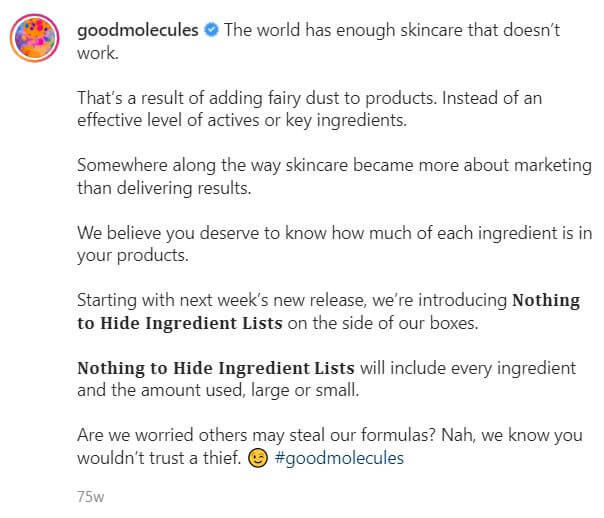
“The world has enough skincare that doesn’t work. That’s a result of adding fairy dust to products. Instead of an effective level of actives or key ingredients.”
The fact they said this right as they were showing the world they had a “fairy dust” amount of vitamin C (and probably licorice extract) indicates to me they don’t know much about their own formulations. They’re sort of telling on themselves.
If they were actually trying to be transparent (and they knew what they were doing), they either wouldn’t make claims they can’t support, or they’d tell you they were using “fairy dust” amounts of their ingredients.
There are other examples of this in the ingredient lists they show:
- The cleansing gel has 0.1% pineapple extract which isn’t enough to “gently purify skin while promoting clarity and softness”
- The glycolic toner has 0.1% aloe extract which isn’t enough to “soothe skin”
- The BHA clarify serum has 0.1% grapeseed oil and pomegranate oil, which aren’t enough to “hydrate”
It’s possible (but unlikely) that they do have super potent fancy plant extracts – and if they did, it would be really transparent if they could tell us about them?
THERE BE CALCULATION ERRORS
Some numbers also don’t add up. It feels a little bit petty to point them out, but if they were going to show everything, maybe they should have checked their working.
The Overnight Exfoliating Treatment claims to have 10% alpha and beta hydroxy acids, but 8.05% glycolic acid, 1.04% lactic acid and 0.10% salicylic acid only add up to 9.19%.
There’s also another 0.1% “fairy dust” issue here:

0.1% salicylic acid is not enough to do anything for acne and sun damage. Claims about acne are also drug claims, and this product is not a drug, making it an illegal claim.
Related post: Sneaky Marketing? The Inkey List Succinic Acid Acne Treatment
This is probably super petty, and I don’t think anyone would’ve noticed unless they were nitpicking as hard as me, but the percentages on the BHA Clarify Serum add up to 100.4%. There are 16 ingredients below 0.4%, so in relation to those this seems like a relatively big error.
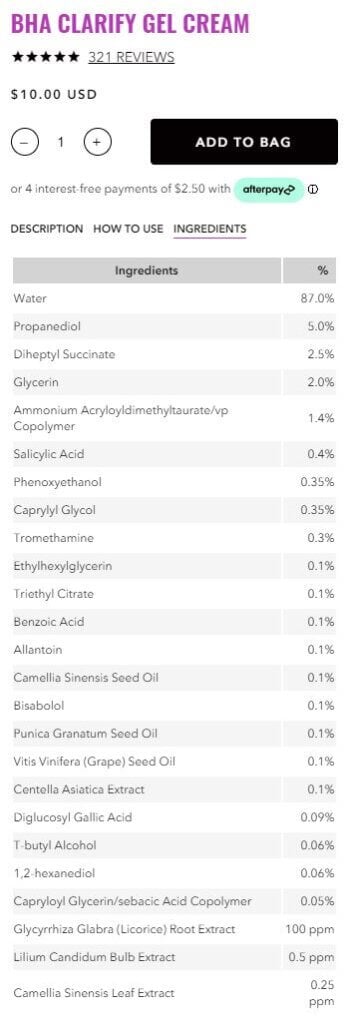
Are they hiding stuff?
A decent number of Good Molecules products don’t have their percentages listed. So saying that they have “nothing to hide” by showing the ingredients for only some of their products implies they have something to hide with the rest.
Better transparency?
There are so many other things Good Molecules could do to be more transparent.
Clinical testing, or why they didn’t do it
They could show us clinical results for their products. Or they could say that they didn’t want to pay for clinical results, because it’s a lot cheaper to base their marketing around just printing out a more detailed ingredient list.
Fearmongering marketing
In one of their Instagram posts, Good Molecules say these ingredient lists “make it easy to see which ingredients we left out.” (Which it doesn’t, no more than a regular ingredient list.) “This includes: Polysorbate 20, fragrance, drying alcohol and a long list of others.”

There are also “free from” claims on some of their products.
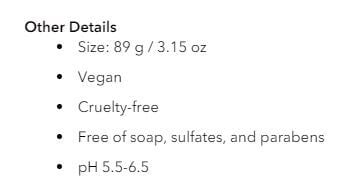
It would be a lot more transparent to not have clean beauty fearmongering. Maybe they could tell people that parabens and sulfates are fine.
Also, their niacinamide serum has polysorbate 60, which is not too different from the polysorbate 20 they called out.
Sponsorship disclosures
Other people have also mentioned that their sponsored posts (especially those from dermatologists) have hidden disclosures, so that might be something to fix if they’re going to be more transparent.
Dodgy claims
They also have a lot of drug claims on their products. For example, they claim rosehip oil will “regenerate and heal skin” which goes well beyond the evidence we have for what rosehip oil does to skin.
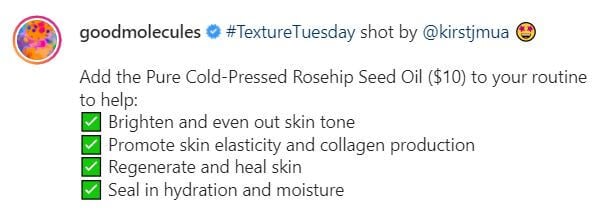
They also say:
“we hope this new level of transparency invites feedback when we can improve”
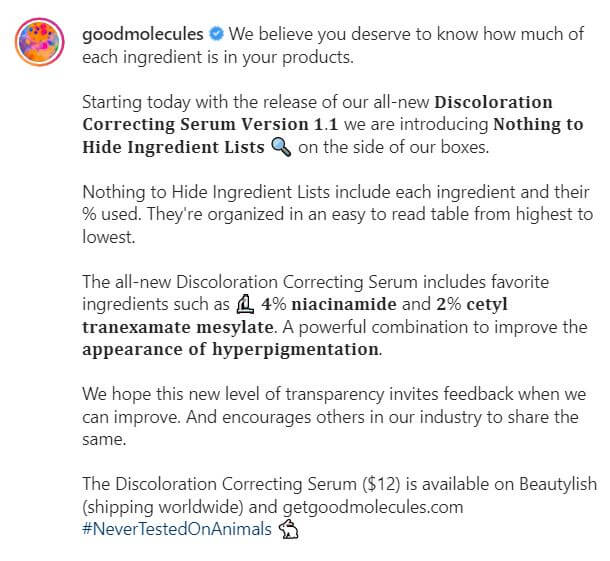
Why not hire someone (maybe a cosmetic chemist) to check their claims instead of waiting for free labour?
Which I realise I’ve just given them, and I should probably write an invoice. (If they pay me, I’ll let you know in the interest of transparency.)
I rate this marketing strategy… a hot mess. Good Molecules do use “fairy dust” ingredients, they didn’t realise they had them, and now they’ve made it really obvious to everyone who knows what to look for.
What do you think of this strategy? And what other questionable marketing claims did you want me to look at?


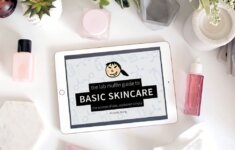
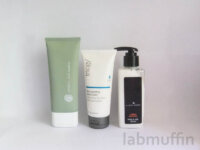
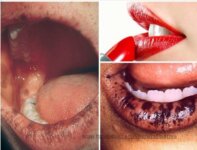
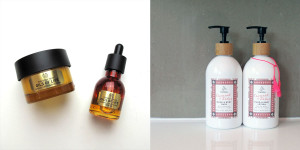
Happy new year !
Excellent and funny when you are upset !
NB : I like to read your articles always science-based which is pretty unique in this cosmetic world.
I may add a point to your comments : what about synergism/antagonism which is far more complex than this transparency list/good molecules seem to believe.
Are interested by the application of antibodies in cosmetics ?
I *super* appreciate your post on this company and their MO. I noticed their packaging and had not had a chance to investigate their practices. Thanks for doing such thorough analysis and for explaining how to spot their BS.
Great post! Of course, the alternative is that Good Molecules 100% know they have ‘fairy dust’ ingredients, they just don’t expect the average consumer to realize this or have a platform from which to call them out!
Interesting article. Thanks.
It never occurred to me that there could be so much variation in quality of the plant extracts.
The question I have is how to choose a good brand.
Personally I use Geek&Gorgeous because the price is ok, the products seem effective and they have a clear communication.
They don’t have a big range and I tend to think that it’s because they don’t release a new product if they are not satisfied.
I see a lot of positive review of Paula’s choice (in the sense that their products are well formulated) but it’s expensive imo.
I will read your other articles 🙂
The fact that they messed up the math is hilarious, thanks for making my day🤣
I like the brand (liked them before they introduced their new ingredient list and continued to like them afterwards), but because of the products I tried, not their marketing claims.
I know this isn’t the point of your article, which states very important facts about why ingredients don’t tell us much about how a product will in the end perform, I guess I just never paid much attention to their marketing strategy because I already knew them.
Oooh, thanks for this. I’m fond of Beautylish, as they carry quite a few brands I really like, and they get bonus points from me for actually bothering to take REAL SWATCH PHOTOS of makeup on *actual living humans* instead of relying on crappy obviously-photoshopped product smears. But I tried their Good Molecules Overnight Exfoliating Treatment and their Hyaluronic Serum, both of which sounded like they’d be great for me, based on ingredients that I know my skin loves and the absence of ingredients I know my skin haaaaates — one appeared to accomplish nothing, the other broke me out (how??). After that, I’m of the opinion that they just wanted to try and steal some market share from The Ordinary, whilst biting their “minimalist” style, but they failed to actually do the science and just went with whatever sounds good (and marketable). An obvious copycat, and with markedly less-effective products. Booooo, no thanks.
As someone who’s regularly bought their Niacinamide toner this was *brutal*, but I can’t say I disagree with the points made. It almost feels like they’re trying to foster an influencer/fan parasocial relationship with that “give us feedback and we’ll release updated formulations!” scheme. Which is interesting, but also kind of concerning.
If anyone is curious about the toner: I do think I see some good results, but I wouldn’t say it’s the most elegant formulation. The glycerin definitely makes me sticker if I don’t layer with moisturizer afterwards. Which I probably would’ve figured out without having the percentage on the box lol.
Hey Michelle, happy new year! I just wanted to say that I really appreciate that you take the time to make written versions of your videos. I really enjoy your content, and as someone with ADHD I often struggle to sit through entire YouTube videos and digest all the information, but with your content I can always come to your website and read the article and not feel like I’m missing out on valuable details, as I find it a lot easier to digest written material. Thank you for this!
I’m glad you appreciate it! I was doing it for myself because I also prefer reading a lot of the time, I recently discovered I also have ADHD so it explains a lot 🙂
Not trying to be rude, but didn’t anyone warn them of this marketing strategy? How dumb can they be, to tell on themselves?
Fascinating, as someone with a science background (bacteriology) I often spot really awful statements and claims that don’t hold up under any kind of scrutiny but I continue to try and educate myself about ingredients and formulations to try and spot the good products from the bad preferably before I pay good money for them. In the end though you usually need to try them to see if they work for you. Reviews help but how many tell you how nice the product is to use or that the packaging is nice without every really addressing if it seems to actually work!
I adore you.
they were popular on tik tok and I got some stuff. I don’t like the fear-mongering marketing at all. I notice I get ads for them frequently too